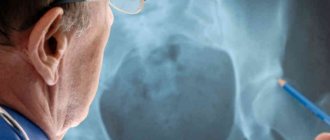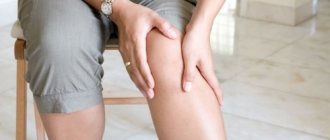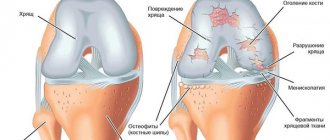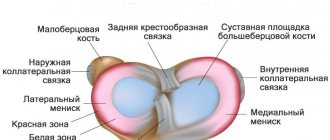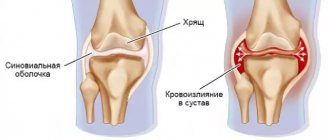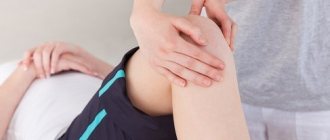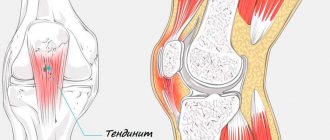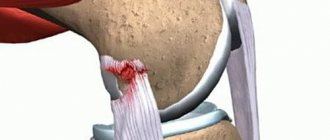Narrowing of the joint space can be detected using the most common x-ray. Severe pathology is visible to the naked eye and can even be palpated by an experienced doctor. Most often, additional examination is necessary for differential diagnosis and to exclude the possibility of oncological intra-articular processes. Narrowing of the joint space is a pathological process caused by disruption of internal processes in the joint capsule. Normally, the joint capsule contains a sufficient amount of synovial fluid for the full sliding of the heads of the bones during movements. Any joint in the human body consists of the heads of individual bones, which are connected in this way to each other. The heads of the bones are covered with hyaline cartilage. When compressed, it releases synovial fluid, and when expanded, it absorbs back. This effectively protects bone tissue from destruction. By contracting and expanding, cartilage ensures uniform distribution of shock-absorbing load over all articular surfaces.
Sufficient height of the joint space allows this mechanism to work with maximum efficiency. When the heads of the bones are too close together, the joint space narrows. The cartilage layer covering the bone tissue has little room to expand and absorb synovial fluid. This starts the process of dehydration of the hyaline cartilage and its gradual deformation.
As the cartilaginous synovial membrane is destroyed, bone tissue is exposed. When moving, the heads of the bones begin to touch each other. Cracks and chips form on their surface. They begin to fill with deposits of calcium salts. This is how rough bone growths appear, which injure the joint capsule and limit mobility. This is the third stage of deforming osteoarthritis. With it, treatment is possible only with the help of joint replacement surgery.
If your X-ray reveals even a slight narrowing of the joint space, do not wait until the problem resolves on its own. It will not happen. Gradually, the condition of the joint will only worsen. Over time, you will develop osteoarthritis. It is very difficult to treat this pathology. It is possible to do without surgery only at stages 1-2. Next, joint replacement will be required.
Contact an orthopedist as soon as you notice the appearance of characteristic clinical signs of narrowing of the joint space. The article describes the primary symptoms, in which an experienced doctor will definitely prescribe an X-ray examination of the affected bone joint.
In Moscow, you can make an appointment for a free appointment with an orthopedist at our manual therapy clinic. Here you will receive experienced doctors who will make an accurate diagnosis and give all the necessary individual recommendations for complex treatment to restore the normal height of the joint space.
Causes of joint space narrowing
It is generally accepted that the cause of narrowing of the joint space is arthrosis, which disrupts the biochemical and physical properties of the synovial intra-articular fluid. In reality, everything is much more complicated. The fact is that arthrosis is an independent orthopedic disease that can occur due to the negative effects of various pathological factors. And it is these factors that are potential causes of joint space narrowing.
Let's consider the most basic potential causes of narrowing of the joint space and the development of deforming osteoarthritis. Let's start with some basic anatomy and physiology. So, a joint is an articulation of bones that allows you to perform a certain range of movements. The joint capsule is isolated. This is a dense cartilaginous shell that provides insulation of the heads of bones from other tissues. The stability of the position of the heads of bones in the joint capsule is ensured by the ligamentous and tendon apparatus, and the muscles passing near the joint. If the integrity of the ligamentous, tendon or muscular apparatus is violated, secondary instability of the position of the heads in the joint capsule occurs. As a result of this, they begin to shift relative to each other, stretching the joint capsule. Excessive intra-articular pressure may occur.
Arthrosis and narrowing of the joint space can occur for the following reasons:
- excess body weight - every extra kilogram greatly increases the shock-absorbing pressure on the articular surfaces; in obese people, the cartilaginous synovial membrane cannot expand fully and early degenerative destruction begins;
- maintaining a sedentary lifestyle - the process of microcirculation of lymphatic fluid and blood is disrupted, stagnation occurs and the nutrition of joint tissues suffers;
- sedentary work with a long position of the body in static tension - the processes of diffuse nutrition of the cartilaginous and connective tissues of the joints are destroyed;
- rheumatic processes leading to systematic inflammation of the synovial cartilaginous membranes inside the joint (ankylosing spondylitis, systemic lupus erythematosus, scleroderma, autoimmune types of arthritis, rheumatism, etc.);
- hard physical labor;
- injuries to the bones whose heads enter the joint;
- poor nutrition and lack of essential nutrients, some vitamins and minerals;
- endocrine pathologies;
- poor posture and incorrect foot placement;
- some types of professional activities.
Among the potential causes of the development of arthrosis and narrowing of the joint space at a young age is a high risk of injury. Hemarthrosis, ruptures and sprains of the ligamentous and tendon apparatus - all this can provoke degenerative processes. In old age, gerontology and related problems with deformation of various tissues in the body come to the fore. In women, in the vast majority of cases, narrowing of the joint space is associated with hormonal dysfunction and osteoporosis.
Diffuse type of disease
The second stage of the disease is otherwise called “diffuse osteoporosis.” Typical for this stage of pathology is the appearance of malignant tumors. The bones become very thin, but are not always subject to fracture. It is diagnosed in patients over 50 years of age, but can also affect children. The causes of the disease are different:
- changes in hormonal levels;
- malfunction of the thyroid gland;
- unbalanced diet;
- heredity.
The diffuse type of the disease, as well as grade 1 osteoporosis of the knee joint, can be detected using an x-ray, which shows a noticeable thinning of the bones. Timely diagnosis can prevent bone loss.
Types of joint space narrowing
An X-ray image of a joint can tell a lot about what pathological processes occur in the intra-articular capsule. There are different types of narrowing that are inherent in certain diseases.
A slight narrowing of the joint space may be the initial stage of the development of arthrosis, or may indicate dehydration of the body. A decrease in the volume of intra-articular synovial fluid is also often associated with increased stress on the musculoskeletal system. If a person is on his feet for a long time during the day, then there is a high probability that he will experience a narrowing of the joint spaces in the large joints of the lower extremities.
A pronounced narrowing of the joint space indicates that the cartilaginous layer covering the heads of the bones in the joint is undergoing a serious degenerative dystrophic process. He has probably already lost the ability to fully straighten out. With this conclusion, the doctor will understand that shortening of the ligamentous and tendon apparatus has already occurred and it will be quite difficult to restore the physiological structure of the joint. But this is still possible, since there is no complete destruction of the cartilage layer.
Sclerosis and narrowing of joint spaces is a dangerous condition. If you ignore it, the destruction of the cartilage layer will soon begin and growths will begin to form on the surfaces of the bones. This condition is likely to result in the person losing the ability to walk or perform movements without assistance. He will be constantly haunted by excruciating pain that does not go away after taking non-steroidal anti-inflammatory drugs.
Uneven narrowing of the joint space may be present with partial destruction of the cartilaginous synovial layer. This condition corresponds to the second stage of deforming osteoarthritis. Amenable to conservative treatment using manual therapy methods.
Prevention of osteoporosis of the knee joint
Prevention of the disease should begin at a young age. It is recommended to adhere to the following standards:
- lead an active lifestyle (biking, running, gymnastics);
- adhere to proper nutrition (food with the necessary content of calcium and minerals);
- to refuse from bad habits.
It is necessary to undergo regular bone density testing. Monitoring older patients with a doctor will eliminate the risk of fractures. Osteoporosis of the knee joint is a common disease. It will not be possible to overcome it with medications alone. Timely contact with a specialist can prevent bone destruction. Lifestyle changes and proper nutrition are the key to effective treatment of osteoporosis.
Narrowing of the joint spaces of the lower extremities
Most often, X-ray images reveal a narrowing of the joint space of the knee joint, since this joint of the bones bears the maximum shock-absorbing load during movements. In second place in terms of detection frequency is narrowing of the joint space of the hip joint. An X-ray may be required even if the patient reports pain in the knee area. Coxarthrosis often causes referred pain in the knee.
Narrowing of the ankle joint space may be associated with distal separation of the tibia and fibula. Also, a similar pathology occurs with plantar fasciitis, improper placement of the foot in the form of flat feet or club feet.
Narrowing of the joint spaces of the foot is relatively rare. But if the foot is positioned incorrectly, all the small bones become displaced and deforming osteoarthritis develops. This appears in the form of constant dull pain, intensifying after a long walk.
What is osteoporosis of the knee joint
With osteoporosis of the knee joint, the symptoms are not obvious at the initial stages, but timely treatment helps to avoid further development of the pathology. The disease manifests itself in deformation of tissues and joints. The disease can affect both the skeletal system in general and individual parts. The knee joints cease to be elastic, which leads to severe spasms when walking. Failure to detect the disease in a timely manner can result in irreversible consequences. Bone deformities can make a person disabled.
Narrowing of the joint spaces of the upper extremities
In the upper extremities, the level of physical, shock-absorbing and mechanical loads on the articular surfaces is much lower than in the legs. But representatives of certain professions are often diagnosed with narrowing of the joint space of the shoulder joint. Typically, painters, builders, finishers, etc. suffer from this pathology.
People who play tennis often experience a narrowing of the joint space of the elbow joint, gradually leading to the complete destruction of all tissues. They develop an occupational disease known as tennis elbow. Then, as the ligaments and tendons are destroyed, deformation of the intra-articular cartilaginous tissues is observed.
Narrowing of the joint spaces of the hands is almost always associated with the development of systemic pathologies. This may be the articular form of ankylosing spondylitis, polyarthritis, systemic lupus erythematosus, gout, Raynaud's disease and a number of other serious pathologies.
Diagnostics
- A survey and examination by an orthopedic traumatologist reveals typical signs of degenerative-dystrophic joint disease (pain on palpation, limited mobility, crepitus, deformity, effusion in the joint).
- An x-ray examination of the knee joint is performed (narrowing of the x-ray joint space, the presence of osteophytes, subchondral sclerosis is determined), and, if necessary, a computed tomography scan of the joint.
- Ultrasound examination of the joint can detect thinning of the cartilage in the joint, changes in the ligaments, muscles, soft tissues around the joint, inflammatory effusion in the joint cavity, and changes in the menisci.
- The most accurate information is provided by magnetic resonance imaging of the knee joint, which reveals changes in cartilage and bone tissue, ligaments, menisci, synovial membrane, allowing to differentiate post-traumatic arthrosis of the knee joint and arthritis, tumor process.
- Diagnostic puncture and arthroscopy of the knee joint, as well as laboratory testing of the synovial fluid obtained during the procedure, are widely used in the diagnosis of joint diseases.
How to treat narrowing of joint spaces
There are several approaches to how to treat narrowing of joint spaces; for example, official medicine prefers to practice wait-and-see therapy. A patient with such a pathology is prescribed symptomatic therapy, which allows him to work fully despite the fact that the joints continue to rapidly deteriorate. At the moment when even intra-articular pain-relieving injections no longer help, an alternative method is proposed. This is endoprosthetics. During surgery, the destroyed joint is replaced with an artificial prosthesis. After a period of rehabilitation, the patient is again ready to return to his professional duties.
Manual therapy takes a completely different approach. Treatment of narrowing of the joint space with similar methods is possible only at the 1st and 2nd stages of the development of osteoarthritis. If the cartilage tissue inside the joint is already completely destroyed, then these conservative methods of therapy will no longer help you.
In our manual therapy clinic, treatment for narrowing of the joint space begins with restoring its normal lumen. Osteopathy, manual traction, etc. are used for this. Then the doctor develops an individual course for each patient aimed at restoring the normal height of the cartilaginous synovial layer.
Most often, we use osteopathy and massage to restore impaired processes of microcirculation of blood and lymphatic fluid, and restore the former elasticity of all tissues surrounding the joint. Therapeutic gymnastics and kinesiotherapy are also used - they improve the condition of the muscular frame of the body and provide adequate nutrition to all tissues of the joint. Physiotherapy, reflexology, laser therapy and much more are also used.
If you need qualified medical assistance in the treatment of narrowing of the joint space, we offer you to make an appointment right now for a free appointment with an orthopedist in our manual therapy clinic.
